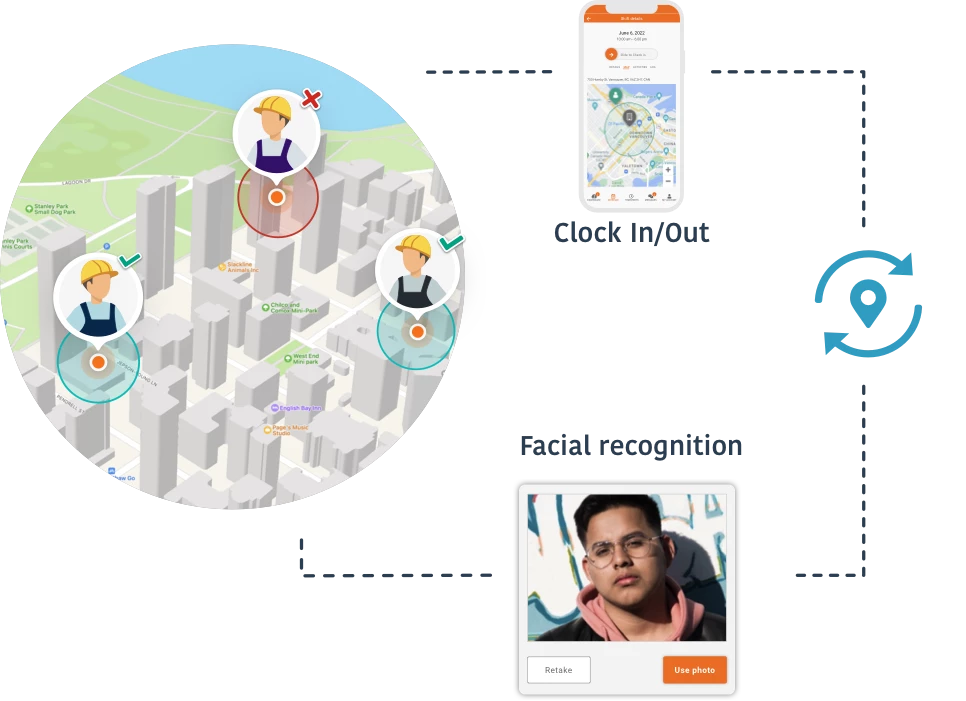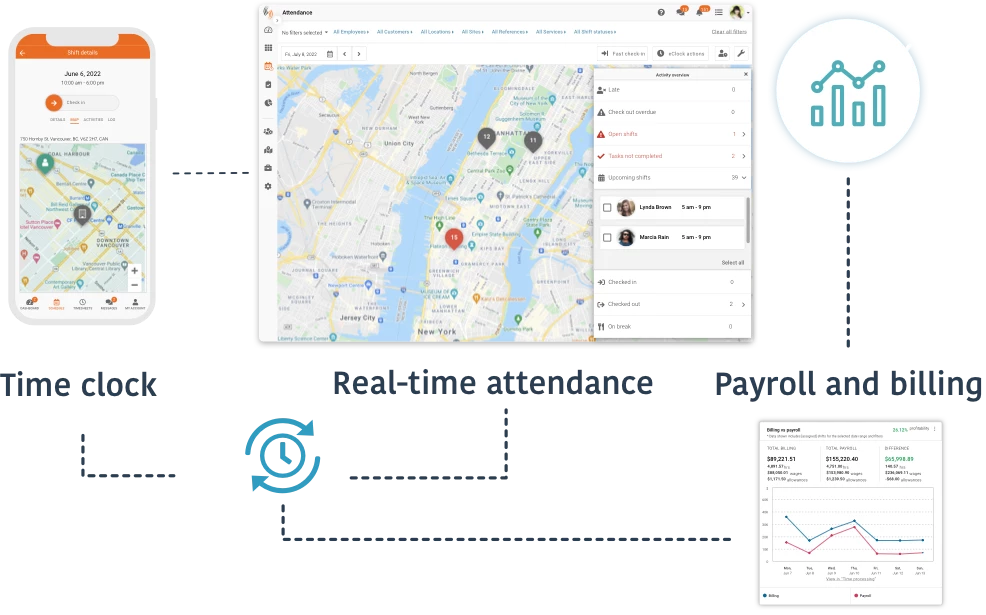As we navigate our way through the complexities of the modern workforce, employee timekeeping remains a critical aspect of efficient business operations. Timekeeping isn’t merely about noting down when your employees clock in and out. Rather, it’s a comprehensive system that ensures fairness, maintains productivity, provides insight into labor costs, and helps adhere to regulatory requirements. Let’s delve into what employee timekeeping is, why it’s crucial for your business, and how you can optimize it in 2023.
What is Employee Timekeeping?

Employee timekeeping is the process of tracking and recording employees’ working hours. This includes the time they start work (clock-in), when they take breaks, and when they finish their work (clock-out). In addition, it often involves recording leave days such as vacation, sick days, and personal time. This data is then used for payroll calculations, labor law compliance, workforce planning, and more.
The traditional model of timekeeping—manual punch cards or logbooks—has largely been replaced by digital solutions. These offer more accuracy, efficiency, and a wealth of data that can help manage your workforce more effectively.
The Importance of Employee Timekeeping
One of the fundamental reasons timekeeping is crucial is payroll accuracy. Accurate records ensure employees are paid correctly for their time, avoiding over or underpayments that can lead to dissatisfaction or even legal issues. It also provides a clear record in case of any disputes over pay. Errors in payroll are not just about money lost/saved by the company, it’s an issue of employee turnover. The Workforce Institute carried out research where 49% of respondents would try to find new employment after experiencing two payroll errors, including being paid the wrong wage, or being paid late. High employee turnover creates further unnecessary costs when it comes to replacing employees, and of course, company knowledge is lost!
Additionally, timekeeping helps with regulatory compliance. Labor laws often require employers to keep detailed records of employees’ hours worked, and failure to comply can result in penalties. Timekeeping also provides valuable data for workforce management and planning. By analyzing when, where, and how long employees are working, you can identify patterns and trends, enabling you to allocate resources more effectively and improve productivity. Finally, timekeeping promotes fairness and transparency in the workplace. It ensures that all employees are treated equally and that work hours, overtime, and time off are managed fairly.
Best Practices for Employee Timekeeping in 2023
As we move into an increasingly digital and remote work environment, the tools and techniques for timekeeping are evolving. Here are some best practices for 2023.

Invest in Robust Timekeeping Software
The foundation of effective timekeeping in 2023 is a robust, feature-rich software solution. Look for a system that can handle all aspects of timekeeping, from clocking in and out to tracking breaks and leaves. It should offer flexibility to cater to different working arrangements, such as remote work, flexible hours, and part-time work.
The time and attendance software should also provide reporting and analytics features, allowing you to extract valuable insights from your timekeeping data. This can help in identifying bottlenecks, improving scheduling, and optimizing workforce productivity. Celayix has a robust feature set for everything you need including geofencing for mobile workforces, an app for mobile check-in/out functionality, and more.
Use Biometric Time Clocks
To enhance accuracy and prevent time theft or “buddy punching” (where one employee clocks in for another), consider using biometric time clocks. These devices use unique biological characteristics, such as fingerprints or facial recognition, to identify employees when they clock in and out. This not only enhances accuracy but also adds a layer of security to your timekeeping system.
Automate Payroll and HR Processes

To maximize efficiency, integrate your timekeeping software with your payroll and HR systems. This allows for automatic transfer of data, eliminating the need for manual data entry and reducing the risk of errors. It also makes it easier to manage aspects such as overtime, leave, and shift differentials. Speaking of shift differentials, Celayix has a great feature – automated attendance matching which updates your schedule as soon as a shift is completed with the actual hours worked. This can then be handed off to payroll and billing as needed.
Train Your Employees
Ensure your employees understand the importance of accurate timekeeping and how to use the system correctly. This should include training on clocking in and out, recording breaks, and requesting leave. Make sure they understand the consequences of time theft.
Embrace Real-Time Tracking
Encouraging employees to track their time in real-time, rather than retroactively, significantly enhances the accuracy of your timekeeping data. Real-time tracking enables you to identify potential productivity issues and make necessary adjustments to workflows in a timely manner. Automated time-tracking tools, such as apps, can greatly facilitate this process.
Regularly Review and Analyze Timekeeping Data
Consistently reviewing and analyzing your timekeeping data is vital for identifying areas of improvement, optimizing workflows, and enhancing productivity. This data can inform decisions on employee performance, resource allocation, and project management. Regular analysis can help you identify trends, and patterns, and adjust operations accordingly to achieve your business goals.

Avoid Common Employee Timekeeping Mistakes
Time tracking can be a powerful tool for managing resources, increasing productivity, and optimizing workflows. However, to reap these benefits, it’s crucial to avoid common mistakes:
- Not collecting enough detail about employee work hours: Basic information like start and end times isn’t sufficient. Collecting more detailed information, such as the tasks or projects worked on, and the specific activities performed, can provide valuable insights into how employees are spending their time, which tasks or projects are taking longer than expected, and where productivity can be improved.
- Failing to integrate time tracking with payroll: This can lead to errors and discrepancies, such as overpayments or underpayments. Integrating time tracking and payroll systems ensures accurate and timely employee compensation, streamlines administrative tasks, and reduces the risk of errors associated with manual data entry.
- Not leveraging time-tracking software features: Most time-tracking software programs offer features that can optimize workflows and increase productivity. Not using these features, such as reports and analytics, can result in missed opportunities for improvement.
- Relying solely on manual time tracking: Manual time tracking can be prone to errors and inaccuracies. Automating time tracking using software improves accuracy, reduces administrative burden, and provides more detailed data.
- Allowing employees to estimate time worked: This can lead to inaccuracies and overestimations. Encouraging real-time tracking and providing training on how to accurately track time can help avoid this mistake.
- Failing to enforce time tracking policies: Clear time tracking policies are important, but failing to enforce them can render them ineffective. It’s important to hold employees accountable for accurate time tracking and to address any policy violations promptly.
Celayix has been in the employee timekeeping and workforce management space for over 20 years. We’ve helped countless organizations get their operations in shape with our software, and we can help you too! If you’d like to hear more, we can create a free custom demo for you!





